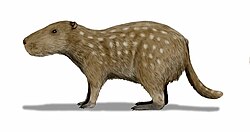| Tsaganomys | |
|---|---|
 | |
| Fossil skull and jaws (IVPP V11390) of T. altaicus, Paleozoological Museum of China | |
| Scientific classification | |
| Domain: | Eukaryota |
| Kingdom: | Animalia |
| Phylum: | Chordata |
| Class: | Mammalia |
| Order: | Rodentia |
| Family: | † Tsaganomyidae |
| Genus: | † Tsaganomys Matthew & Granger, 1923 |
| Species: | †T. altaicus |
| Binomial name | |
| †Tsaganomys altaicus | |
Tsaganomys altaicus is an extinct species of rodent from Asia, and the only species in the genus Tsaganomys. [1]

Junior synonyms and likely junior synonyms: [2]
- Cyclomylus lohensis
- Cyclomylus minutus
- Sepulkomys eboretus
- Beatomus bisus
- Pseudotsaganomys mongolicus
- Pseudotsaganomys turgaicus














